Equipment
The greatest Ben Hogan irons of all time

Ben Hogan was a perfectionist. From his swing to his golf club designs, it was always about striving to get things just right. Although younger generations may not connect to the Hogan brand the same way golfers from an older generation would, I believe it is important to recognize the impact the man had on the game, golf equipment, and design.
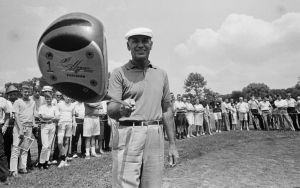
One of the most famous stories surrounding the founding of Ben Hogan golf is how Mr. Hogan’s desire for perfection actually drove away one of the company’s initial investors when he refused to go to production with any of the prototypes produced over the first six months. That lead to one of the other partners who had absolute trust in Hogan’s approach to purchase the shares of the nervous party. It went even further in 1954 when the first production run arrived and they too were also not up to Hogans standards—this resulted in the company destroying over $100,000 worth of inventory which today is over one million dollars—not small change for a startup company.
Eventually, the production issues were sorted out, and in 1954 the original Precision iron was introduced, the rest, as they say, is history. Although Ben Hogan Golf has gone through a number of changes since its original inception, one thing has remained the same—the constant pursuit of creating the best golf clubs possible.
These are some of the finest examples.
Ben Hogan Precision – Released 1954
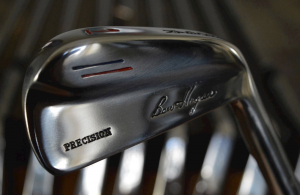
Photo: Ben Hogan Vintage .com
This is the iron that went through all of the production changes before finally coming to the market in 1954. It is “the granddaddy of all modern blade designs,” as Patrick Boyd likes to point out.
The key element of this clubhead is the mass positioned lower in the head to create the modern muscle back style we know today as well as the notched toe to position more mass in the middle of the head behind the hitting area.
Beyond some minor tweaks and shaping, it’s easy to see why this is one of the most influential club designs ever.
Some of the most iconic designs from Mizuno—including the MP-14, MP-29, TN-87, and MP-37—have all utilized this toe cut design to help move mass—you can even see it still in the MP-20s. Obviously, a lot has changed as far as production, tooling, and tolerances, but the overall shaping is easily recognized.
An interesting question is, why, after winning the triple crown with his MacGregor Personal set in 1953, Hogan chose to forgo a lot of the design cues of that set and strike his own path in design. Whatever the answer, it was obviously the right choice.
Ben Hogan IPT – Released 1963
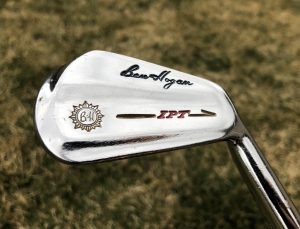
“IPT” stands for Improved Power Thrust.
With the original version of the Power thrust released in 1960, Hogan had started to experiment moving mass away from the toe area and pushing it towards the center of the head. It helped position more mass behind the striking area and closer to the shaft axis to increase workability. The IPT took that concept further and introduced the very first Ben Hogan iron with the muscle-on-muscle design. It removed mass away from the perimeter of the head and put it where it is most effective. This design element has been a key feature of almost every Ben Hogan iron that came after it.
Ben Hogan Apex – Released 1972
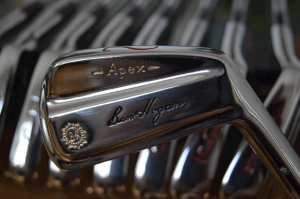
Photo: Ben Hogan Vintage .com
The shape of the 1972 Apex was not new at the time of its release—it’s basically the same head design as the Bounce Sole irons, which debuted in 1970. What makes this iron so iconic is the name “Apex”—this was the first! The Bounce Sole was iconic in its own way, because in this era of clubs the sole had more bounce and was much more cambered than other clubs on the market.
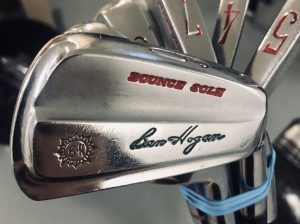
Although Callaway owns the rights to the Apex (name thanks to the acquisition of Hogan assets when they purchased Spalding) and have rightfully done the name justice, classic gear buffs will always associate Apex with Ben Hogan. The most discussed feature of this head is the shifting weight pad to raise the CG and improve trajectory control. To me, this iron epitomizes Ben Hogan’s desire to create golf clubs to offer maximum control for players seeking precision instruments. Elements of this design are alive and well with some of the irons produced by National Custom Works.
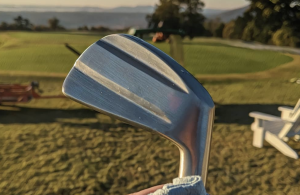
Ben Hogan Edge – Released 1989
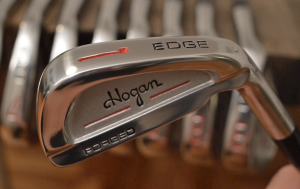
Photo: Ben Hogan Vintage .com
For Hogan iron purists, the Edge might seem like an odd club to find on this list, but let me assure you it holds an important place in the history of the company.
Up until the release of the first Edge iron, Hogan irons were strictly forged blades. The Hogan Edge was the very first full production forged cavity back iron from a major manufacturer. They were produced by Cornell Forge in Chicago, and pictures of their production process were prominently displayed when entering their facility. “Full production” is the key phrase there because Ping’s first iron the Ballnamic 69 were made from forged Golf Craft blank heads and milled out to create perimeter weighting (see below).
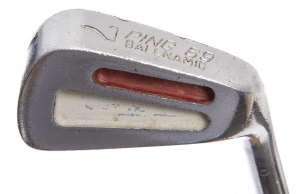
Photo: Second Swing Golf
Ping irons actually played a big role in the development of the Hogan Edge, since it was only a few years prior in 1982 that Ping released the Ping Eye 2 iron with its perimeter weighting. These new forgiving cavity back clubs were sweeping the world of golf. Everyone from professionals to amateurs starting adapting more forgiving cavity back irons and Hogan needed to fight back. They did just that with the Edge, and if you look closely at the design with the more swept toe and offset, you can see Karsten Solheim’s Eye 2 had a big influence on the Edge.
Ben Hogan Apex – Released 1999
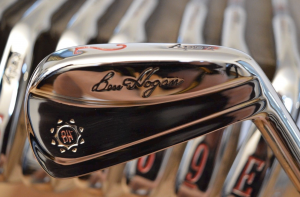
Picture: Ben Hogan Vintage .com
Jeff Sheets is the man behind a lot of important designs and breakthroughs in the golf industry, and he still calls the ’99 Apex one of his all-time favorite designs.
This is from Jeff himself on how this iron came to be courtesy JeffSheetsGolf.com
“… I was ready to pursue this project only after doing much homework, studying every Hogan design I could find and by interviewing past Hogan Company employees. In my research of studying Mr. Hogan’s design characteristics, I ended up creating the infamous Hogan iron chart using a 1-megapixel digital camera and black fabric backdrop as I photographed every iron on my credenza “photo studio”. I had two big assets available to me in the execution of the new Hogan Apex irons. The first was my CAD operator Charles Lovett who had a keen eye for blades after he had been hired away from Mizuno. The second was my prototyping contractor Tom Stites, an ex-Hogan R&D staffer who would convert our CAD files to hittable specimens. The ’99 Apex is the epitome of a Hogan forged iron design. It was the first Hogan iron to be forged by Endo Manufacturing in Japan. Stite’s group, Impact Engineering, did such a fine job on the final prototypes that we were able to laser scan them for creating the forging dies.”
After reading off all the names involved with this project, it’s no wonder this is still considered one of the greatest Hogan irons of all time. Jeff went on to design for Golfsmith and still operates his own design consulting company to this day. Tom Stites’ Impact Engineering was purchased by Nike and became Nike Golf, which is why it was located in Fort Worth of all places, and the master shaper at Impact was none other than Mike Taylor of Nike and now Artisan Golf.
This iron holds a special place in Hogan fans’ hearts because it was the first club released after Spalding purchased the brand in the late ’90s. Many diehards fans worried Spalding would just use the name to sell inferior lines of clubs on the back of the Ben Hogan name and in a way disrespect the legacy built by Mr. Hogan. This design by Jeff Sheets put those fears to rest, and thanks to the backstory behind it, has lived on to become a highly regarded set.
The Future of Ben Hogan Golf
![]()
Today, Ben Hogan Golf exists as a direct-to-consumer brand, and they continue to push the boundaries of design and develop clubs for both discerning players and those looking for a little extra forgiveness. Their newest iron, the Icon, combines a lot of the key elements of previous Hogan irons, and the question is now whether it will earn its place among others on this list.
Special thanks to Patrick Boyd of National Custom Works and Boyd Blade and Ferrule Co, for his help with this piece. He is a walking encyclopedia of classic forged iron knowledge.
- LIKE754
- LEGIT68
- WOW44
- LOL9
- IDHT10
- FLOP14
- OB7
- SHANK23
Equipment
Q&A: The truth behind Bryson DeChambeau’s new Avoda irons from company founder Thomas Bailey

During the week of the Masters, news broke that Bryson DeChambeau was using 3D-printed irons from a relatively unknown company called Avoda Golf.
DeChambeau fired an opening-round 65 at Augusta National using the irons, sending the equipment world into a frenzy trying to figure out who the company is, and what’s different about the irons. Information about the irons, however, wasn’t so easy to find. No one really knew much about Avoda or his new iron designs.

Then, ahead of the 2024 U.S. Open at Pinehurst, GolfWRX.com got its first in-hand look at the irons, and DeChambeau provided a public explanation of the flight-correctional “bulge” that the irons have on their faces.
DeChambeau went on to win the U.S. Open using the bulge-faced 3D-printed irons, but we still didn’t know much about the irons themselves.
Until now.
Recently, GolfWRX.com spoke to Thomas Bailey, founder of Avoda Golf, to find out more about the company, and DeChambeau’s mysterious irons. Enjoy our full Q&A with Bailey below!
Andrew Tursky, GolfWRX.com: So what is Avoda? How did the company get started in the industry?
Thomas Bailey, founder of Avoda Golf: Originally, I just wanted to make myself a set of golf clubs. That’s the truth. So that’s a year ago to date of Bryson winning the U.S. Open.
It’s been a crazy year.
I wasn’t quite happy with what I was looking for from a club and what was available on the market. I played around with a lot of the same-length products for a while. I got to the point where I was grinding the heads myself, taking heads and grinding them away to get the weights I wanted, to get them the appearance how I wanted. And I got pretty dialed in on a set I wanted over a two-year period. It just felt like it had been mauled by a bench grind.
So we were using raw heads, from Kyoei, and taking them down to weight. When I say we, that’s myself and Mike Schy, Bryson’s long-time coach from out at Dragonfly Golf Club in California. We were just grinding away golf clubs, seeing if we could create the ultimate club for what I wanted; and we got it. It just felt like it had been attacked by a bench grind.
So the mission then came in to make it presentable. My brother actually worked in the firearms industry and had a lot of supplier and manufacturer relations, so he worked on finding me a manufacturer who would be happy to put together the clubs for the specs I wanted. And we got there. We went through a number of suppliers and manufacturers to try and get to the point of what we wanted. We got it and had a prototype set come in around October last year, which was spot on. It was exactly what I wanted.
The goal was when I got that set in was to maybe make 50 sets and sell them, and fund my own golf career and my own golfing habits.
So right around that time, Bryson was coming back into town. He just had a win and shot 58 with the new driver in the bag, and he wasn’t happy with irons. They didn’t complement what he’d got right with the driver. The driver had more onset with more bulge to it. The swings he was making with that and having great success off the tee just didn’t work when he went to an iron. So he was saying say he would be fighting his iron play, fighting a left miss if he made the swing he wanted to, and then fighting a right miss to compensate for it. And that would then leak back into the driver to where he’d be missing with the driver, as well. He knew he needed new irons in the bag.
I know him and Mike Schy had explored a few options to try and find someone to do the irons. Right around that point, I told Mike that I’d been working on my own set of irons, that we could always explore doing something for Bryson, as well. And that’s kind of where it started. It’s like, well, nothing to lose. Let’s go for it. Bryson was in town in September, testing some irons and stuff again, having the raw Kyoei’s and grinding them down, getting the appearance he wanted.
He was on the bench grind, as well, and they got a head, and then the conversation started around putting bulge into an iron.
Mike goes, “Well, why don’t we test bulge on an iron?”
And Bryson asked, “Can we do that?”
And it was like, well, let’s find out.
So, he actually went into the academy where he’s got his workshop and started grinding away the toe on the Kyoei heads to try and put a little bit of curvature to it.
Wait, Bryson himself was on the grinding wheel?!
TB: Bryson was on the grinding wheel shaping the club to how he wanted them to look.
We actually had my partner’s dad, he was welding up the back of the club to give him extra weight to play with on the grinding. So it was a right interesting process, but he got it down to the shape he wanted, and then they started grinding. Mike went back into the academy and started grinding away some other toe section to get some curvature on the face to start testing the bulge-face idea, and found out very quickly when he was hitting them.

GolfWRX’s in-hand photos of Bryson’s 5-iron at the 2024 U.S. Open
Bryson went back to hit them and said, “Yeah, this is it. This is what we need to test.”
So, I set about making two identical heads – 7-iron heads – to the specs he wanted to see weight-wise and the width of the head he wanted to see. And they were CNC forgings to start with. So we had a flat head, or flat face, and then we did an identical club with a curved face, so we could hit them, start getting some numbers, and seeing what the difference is between them. And immediately, it was a night-and-day difference on the mishits, and just the overall performance of the club. It was more than just the mishits, so we knew we needed to put it into a full set.
He had very specific requirements he wanted to see in terms of the width of the head, the appearance from the top line. He liked the thicker top line. He liked the wider blade. When you start doing that, the head weight goes through the roof, so it couldn’t be a one-piece forging. It had to be hollow-body, which also had the advantage of reducing the spin rate, which is something he’d been struggling with for a while.
So we went about putting together the first full prototype set, which came in, we had it completed around end of January this year. He did some testing with it, took it to Mayakoba, had it in the practice rounds there. He decided not to put it in play just because we overdid the face curvature to begin with, to where we’d actually see the opposite miss, not the ideal. And then we went out making another prototype round, tidying up some of the aesthetics on it a little bit, but, again, dialing in the face curvature.

Bailey says Bryson prefers irons that have thicker top lines, wide faces from heel-to-toe, onset, and a square, symmetrical-looking face (as much as possible when there’s a curve) / Photo credit: Avoda Golf
They arrived the week before the Masters. We strongly believe we were still in a prototyping phase there, and did not expect them to be in play at The Masters. So when we found out Tuesday at the Masters that they were going in play, we went, “Uh, right.”
So him switching into the irons at the Masters was news to you, too?
TB: It was, well, there was some stuff that was going on leading up to that. He had them. He was in testing with them a week and a half before, and he took them to Miami, with the full intention of playing them in Miami.
We sent some stuff off for USGA testing, because, again, we’re still in prototyping at that point. So we sent them off. We wanted to get them tested just in case he did put them in play. We had a couple of groove issues that had to be sorted with the 3D-printing process, just some inaccuracies in the groove. His manager, Connor (Olson), over in Florida, was working hard on fixing them over the weekend before The Masters, and then we had them re-tested on the Monday.
Half the set was good to go, but we needed to get another set over there to fix a couple of clubs. So I get a call on Monday afternoon of Masters Week. I’m on the West Coast, in California, and I get a call at 4:30 in the afternoon from Connor saying we need the other set here, right now. And I’m thinking, “How am I getting this other set for you anytime soon?” And if it was Wednesday, it would have been too late for him to put them in play.
So, luckily, we rushed over to UPS. The guy said that the out-of-state overnight had already gone. We’d missed it, but he put the address in, and said we’ll see if we can get it out on the first shipment in the morning. And when I’m putting the address in, he goes, obviously, reading out the address in Augusta, and he goes, “Oh, Augusta. You going to the Masters.”
And I said, “Yeah, these are Bryson’s golf clubs.”
And he’s like, “You’re kidding me.”
Luckily, he was a golfer.
He goes, “You’re kidding.” And I’m like, “No, these are legit Bryson’s golf clubs. We need to get them there.”
So they ended up rushing them out to the truck, luckily getting them on the truck, and they made it to Augusta at 7:00 a.m. the next morning. So Connor did some work on them, and then they got approved to be used midday on Tuesday. But when we had the issues come back just before the Miami event for LIV, he didn’t put them in the bag there. So we kind of thought, right back to the drawing board. We’ll go again, get ready for the next one. But then it was a miracle to get them ready by Tuesday, we just didn’t see that coming. So yeah. And then they were in the bag.
That’s such an unbelievable story.
TB: Yeah. It’s pretty crazy.
Crazy. I mean, it seems like, you know, there was a lot of stuff going on behind the scenes during the week, but we didn’t really know what was happening, because he didn’t publicly come out and say everything. It’s truly unbelievable.
TB: And then having the balls to put that set in play on Tuesday of the Masters. I mean, he’d been practicing with it for a week and a half, so he knew it was good, and he was adamant he wanted to play it. So, obviously, we were gutted originally when it came back that we had the grooves issue that needed to be fixed. And then obviously to get it fixed in time. It was kind of an emotional roller coaster for us all, including him.
So with all that going on, the fact he put them in play and then goes out and shoots at opening 65 was pretty incredible to see. Then, obviously, everything went from there.
All of a sudden, it’s like, “Who’s Avoda?”
A lot of emails coming in, and a lot of interested parties.
Yeah I mean, I was scrambling. For my job, I have to keep up with the latest equipment, all the custom stuff on tour, and then all of a sudden he comes out with these. It’s like, uhh, I know absolutely nothing about these! I’ve never heard of them. I don’t know what to say!
TB: Yeah, that was funny. So, yeah, I mean, we registered the company end of last year, and the intention was for me to make myself a set of irons I was happy with, and, it will result in creating a really, really good product and a lot of interest straight away when we had people testing it.
So I thought, “OK, let’s get in 50 sets and sell fifty. Let’s see if we can build this thing to a 1,000 set a year business.” And, yeah, we smashed it a lot quicker than we thought we would. And, obviously, we cannot be more grateful to Bryson for giving us the opportunity to get it going. It’s accelerated us 5-10 years ahead of typical business growth. So yeah, it’s been pretty unbelievable. So it’s all systems go now, and getting people in the position to handle it.
Fortunately, I’ve had a lot of people around me at the time who knew I was working on this equipment and had made comments like, “If this works and this is this is a good product, we want to be there. We want to support it, and help grow the business.”
So when the clubs went in play, I sent text messages to every one of those parties: “It’s happening. Get ready.”
What an exciting moment for you and the company. So when did the 3D-printing aspect of this come in?
TB: So the 3D printing purpose of that was just for rapid prototyping. So, originally, it was CNC, the first test. And then because he needed a hollow-body head to achieve the visuals he wanted, and then all the specs he wanted, we obviously had an option of creating a mold to cast it, CNC-ing it in two pieces, or 3D printing.

3D printing gave us the quickest option. We were testing a whole new element to golf, adding curvature on an iron, and speed, with the limited time of an off-season.
LIV, fortunately, giving him a longer off-season was great. If it was the PGA Tour, I think, well, I don’t know how we would’ve done it. We’d still be in testing, just because of how limited time there is to do that. So 3D printing gave us the option to rapid prototype, get clubs in within a few weeks to test. So, I mean, we really did go from the first full set…design work started late November, and then by late January, we had the first full prototype set.
So without the ability to 3D print that, we wouldn’t have got it done in that time frame, so it allowed us to get it done.
Where are these heads coming from? Like are you 3D printing them in-house? Are you ordering from a third party?
TB: We have an international manufacturer, so it’s third party. We do all the design work – we have a designer that’s doing that for us – and then we outsource the manufacturing. It’s been a pretty crazy process, and we’re learning a lot very quickly.
So how does it work with the consumer product? How is that working right now? How can people buy sets? What is the market saying about those? What is the feedback you’ve seen in testing when it comes to amateurs? Because I know Bryson was talking about his swing speed and how it helps him, but, you know, the consumer audience doesn’t swing it like Bryson. So, like, what have you seen with the translation there?
TB: So the products that are available for purchase right now is that initial set I put together. So I put two sets together initially, which is what we’re calling our combo-length set. I played same length for a long, long time. I’m 5-foot-9-inches with shoes on, so I’m not the tallest player. And then I’ve got freaky long arms. So, for me, I’ve always had to play my clubs slightly on the shorter side. I love the advantages of the same length set, however, playing a shorter 4-iron when it’s already shorter wasn’t helping me that much. So I needed to make the 4-iron, and the 5-iron, where I didn’t see the distance gapping dropping off. I needed to make them a little bit longer. So that’s where kind of the grinding the golf clubs came in, getting on the bench grind, taking some weight out so I could make them longer. That’s where that originally happened. So I had to set this combo-length set. Same length to the 8-iron, then progressively getting longer through the 7, 6, 5 and 4 iron.
So that’s the initial product we put together, and did the testing on. Then we released a same-length as well, because it was still requested, the same-length product. And there wasn’t really any, at the time, there isn’t a same-length forged product available, like a truly one-piece forging for the same-length market. So we wanted to provide that, as well. So we had the same-length set the whole way through, and then the combo-length set.
So that’s what’s available for purchase for the market right now. The testing on those, from what we’ve seen, just being able to bridge the gap between variable length and same length, that hasn’t been done yet. We’ve seen people who swore that they would never go to a same-length club, who are now using combo lengths, where they’re same-length from the wedge to the 8-iron, and they’re loving it. And then we’ve also seen people who swore to same-lengths, who would never go away from the same length, but did maybe struggle with a longer wedge, or struggle with speed on the 4-iron, again, going into that combo length set, so it’s really bridged the gap between the two.
We’re calling it “removing the disadvantages of both,” and just taking the best of both, and putting them into one set. So those are the sets that are available to purchase right now. The specific Bryson one is a 1-of-1 set that’s done just for him. He has the only set of that, because it’s such a specific product to him. He plays super upright and the head weights are very unique. Obviously, the face, as well the hollow-body.
My goal has always been to create a product that helps people get better. That was the one that helped him get better. I believe in the custom fitting approach, as well. I don’t plan to sell a club for the sake of it. Like, yes, there’s a massive demand for someone to purchase a specific set just like his, but it would be more just for the sake of hitting the Bryson Club, you know, as opposed to actually a club that the consumer can get better by using.
Right, right. What’s your playing background? Like, were you a designer before? Were you a player before? A professional?
TB: Bit of everything. So, I played college golf, packed in college golf after two years to try and pursue full-time golf, so I went back to the UK to pursue full-time golf. Had some injuries straight off the bat, golf swing related. So in an effort to try and get myself healthy, get myself back playing, I kind of saw everyone, did everything, and just wasn’t quite getting the results and help I needed.
And then I kind of had to dive down the rabbit hole of figuring things out for myself. Got some good advice from coaches like George Gankas along the way. He actually gave me some good information around how the body can set up, how the body can move to reduce the stress on the body. So driving down that rabbit hole actually got myself healthy again.
And then there’s a lot of other people in professional golf that are also injured at top amateur level. I had people coming to me saying they struggle with the same problems I had, golfing related. And that led me into the coaching route. So I coached full-time for about 3-4 years. Had some success in that. I coached a guy out of injury named Laird Shepherd. Coached him out of injury to winning a British amateur, and then ended up coaching a few guys out on the European Tour pretty quickly.
I always still wanted to play, so in the back of my mind, it was like, right, yes, I learned everything to try and help myself get better. I’ve got to continue to pursue my dreams of playing. So I got back playing pretty much full-time golf, came out to the U.S. the beginning of 2022 to see Mike Schy to actually build up a set of golf clubs. And then, one thing led to the next, and it kind of got me down the equipment rabbit hole, and that resulted in a major-winning set.
Going down the equipment rabbit is quite an accurate statement…
TB: Yeah, I’m always asking, “Why?” You know? I’m like, why why why? I’m that annoying kid that says, “Yeah, but why?”
I know Bryson is always saying why, too. So you guys linking up makes so much sense.
TB: It worked quite well. There’s a lot of things that we like to see that are similar in a golf club, as well, so that helps. It allowed me to go away and do the design work knowing that I’m looking for a similar thing, as well. I think the struggle that maybe he’s had in the past, and I can’t speak for him on this 100%, but he has an idea of what he wants to see in a club. He takes it away to someone, and they put what they want to see in a club. And it has to work for the mass consumer. The club that he’s playing, the clubs that these guys are all playing, it has to still be available to the mass consumer. So it has to have the element of being able to be used by everyone. Well, now he has the opportunity to create his set.
So when we did the first run of design work and he said what he wanted to see in a club, it was like, okay, let’s do exactly that, and let’s come back with exactly that. And then if he if he wants to make adjustments from there, he’s making adjustments on what he wants to see. So there’s no, like, fighting in the sense of what I want see in the club. If this is what you want to see, that’s what we’re going to design.
And I know he alluded to it a couple times, but is it a progressive bulge that’s going on through the set? So the 9-iron isn’t quite as curved, 7-iron’s a little more curved, and then 5-iron has the max curve? Is that correct?

TB: Yeah. Okay. So the 5-iron, his being 17 degrees in loft and him swinging a 5-iron faster than most people swing a 3-wood, it’s got to have some curvature on it. It’s got a good amount on it, and then progressively tapers off to being nonexistent. So it tapers out to his pitching wedge to where it’s minimal and then becomes flat through his wedges.
And that’s not what the consumer is necessarily buying, right?
TB: No, our products that are available are flat-faced. They are traditional one-piece premium forging. The advantage of ours are more based around how the set’s put together in terms of the length, the weighting, the shaft options, the customization on that, as opposed to the face curvature. Yeah. Right now, the face curvature is just specific to him.
OK, OK. You’re sitting on an absolutely unbelievable story here. It’s so cool from a gear perspective. A lot of things have been coming together very quickly, and of course he goes and wins the U.S. Open with them in the bag. How are you handling things on the production side?
TB: We’ve been labeled as a DTC brand straight away off the bat. We didn’t have an opportunity to be anything else. Things seemed to accelerate so quickly. So right now, we are working. Obviously, the demand’s been huge. People have been calling. We’re receiving hundreds of phone calls, fitting centers asking if they have our clubs. So we’ve got an awesome demand for people wanting to have our fitting kits and be able to offer our equipment.
I believe in that room more than anything, having someone be able to go and test the club. And if they test the club and they decide they don’t want to go with our club, great. We need to do better, and we need to bring out a better product. We’re pretty confident that when they test it, and go through our fitting system, that they will get a very, very well-fitted club that they will have a lot of success with. So getting out to a custom fitters to offer that option to people to go test.
And if we did have that in place from that first week at the Masters, yeah, business would be 10x what it is right now, but, obviously, we were very unaware that we would be in that position so quickly. I mean, we were we were on the fourth month of, or maybe even the third month at that point, of really actually having a full set. So, yeah, it’s accelerated very quickly, but we’re fast learners, and we’re going to deal with the demand. But getting out to custom fitting centers is our number one priority right now, so people can actually go test, and actually have that experience.
I definitely agree on the custom fitting aspect. Well, I’ve taken up way too much of your time, and those are all the questions I have for now. I feel like we cleared up a lot, though. Congratulations on all the success so far, and we look forward to hearing more from you next time.
See Bryson DeChambeau’s Winning WITB from the 2024 U.S. Open here
- LIKE65
- LEGIT14
- WOW6
- LOL3
- IDHT0
- FLOP0
- OB0
- SHANK0
Whats in the Bag
WITB Time Machine: Jordan Spieth’s winning WITB, 2015 John Deere Classic

At the 2015 John Deere Classic, Jordan Spieth downed Tom Gillis in a playoff for his fourth victory of the season. Spieth entered the final round with a two-stroke lead, bolstered by a Saturday 10-under 61, and was steady enough Sunday to book passage to a playoff at 20 under par. When Gillis wasn’t up to the task, Spieth captured his second trophy at the Silvis, Illinois, event.
Check out the clubs Spieth had in play nine years ago below.
Driver: Titleist 915D2 (9.5 degrees) Buy here.
Shaft: Aldila Rogue Black Limited Edition 60 TX
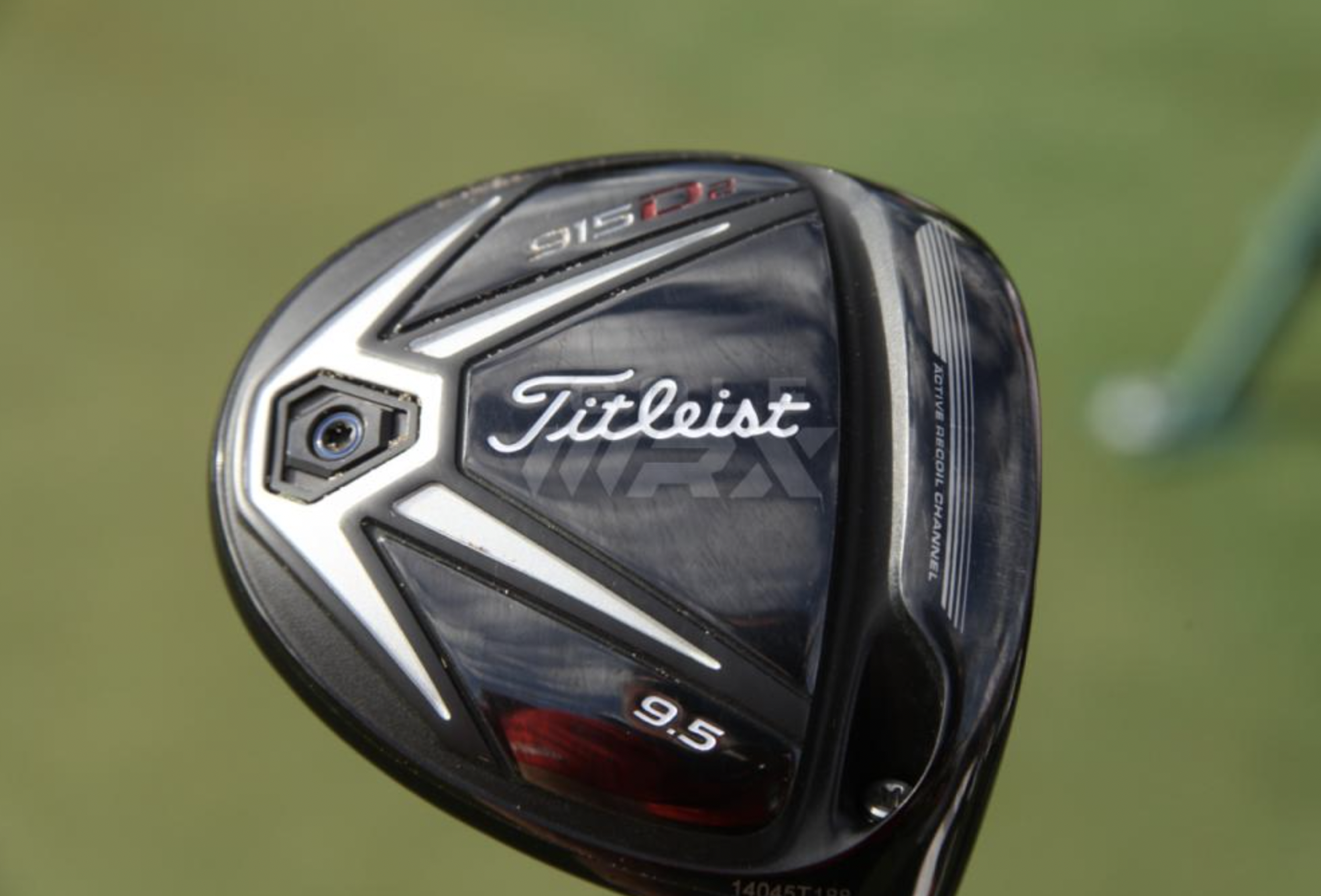
3-wood: Titleist 915F (15 degrees) Buy here.
Shaft: Graphite Design Tour AD DI 7 X
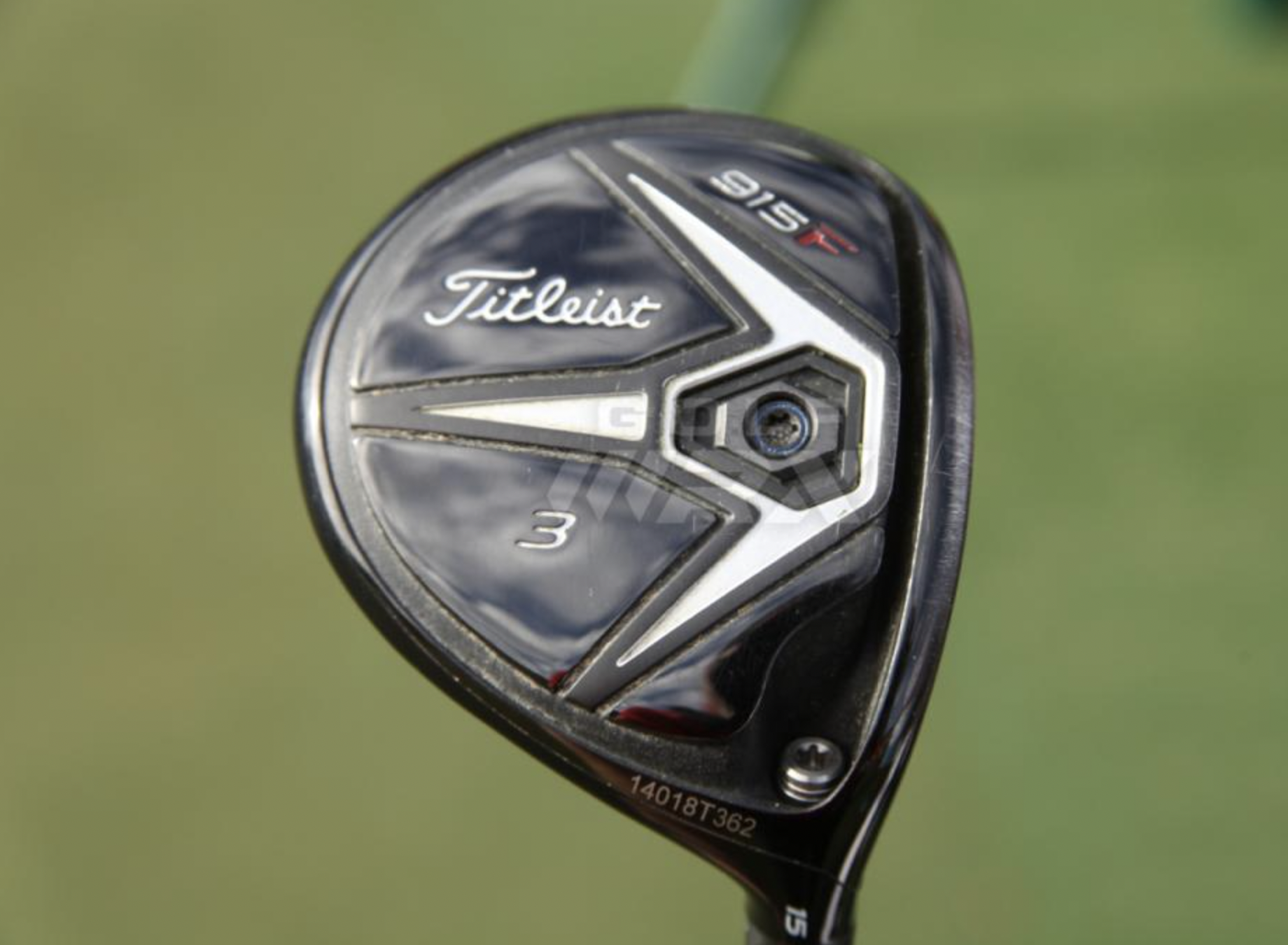
Hybrid: Titleist 915HD (20.5 degrees) Buy here.
Shaft: Graphite Design Tour AD DI 95 X
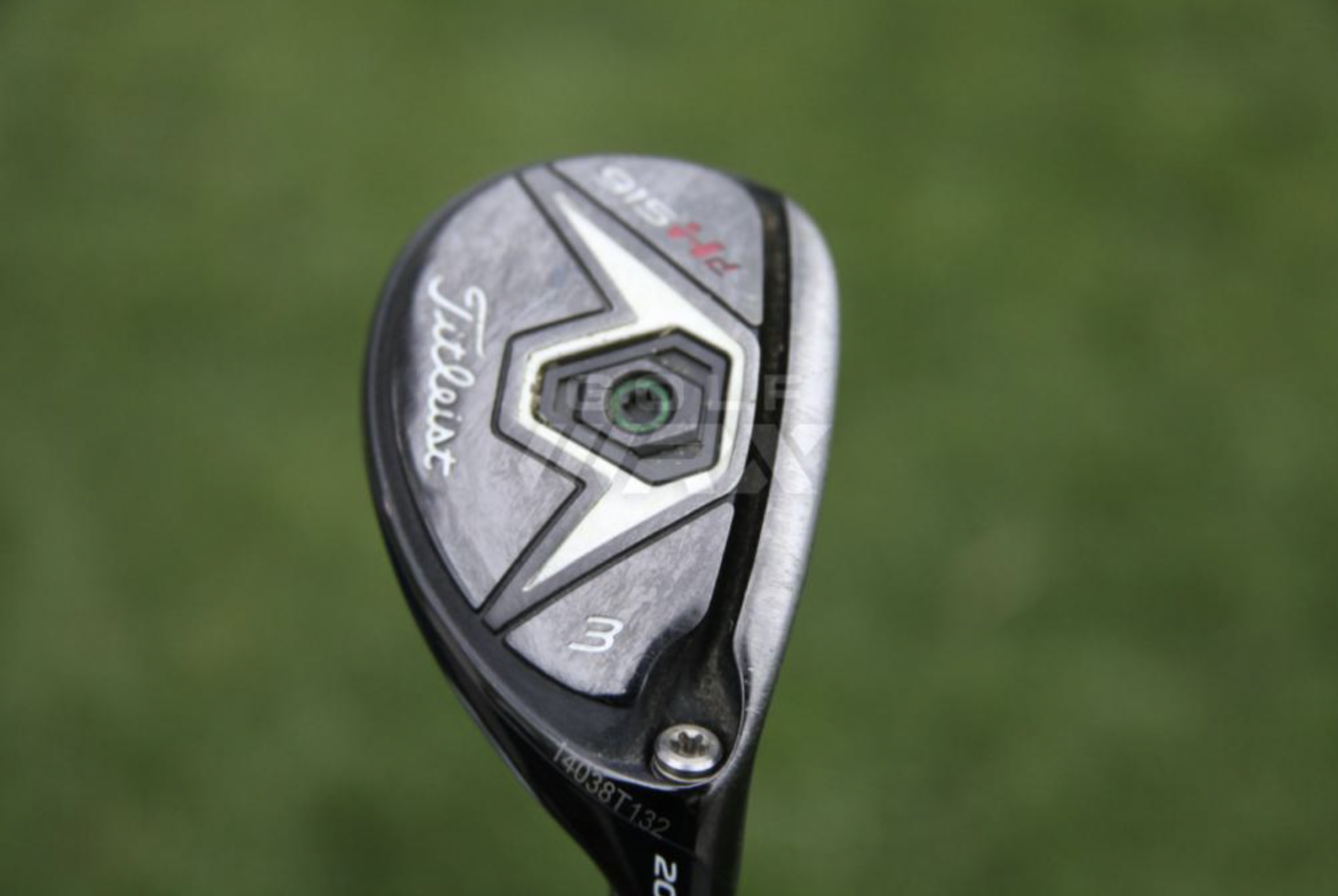
Irons: Titleist 714 AP2 (4-9) Buy here.
Shafts: True Temper Project X 6.0
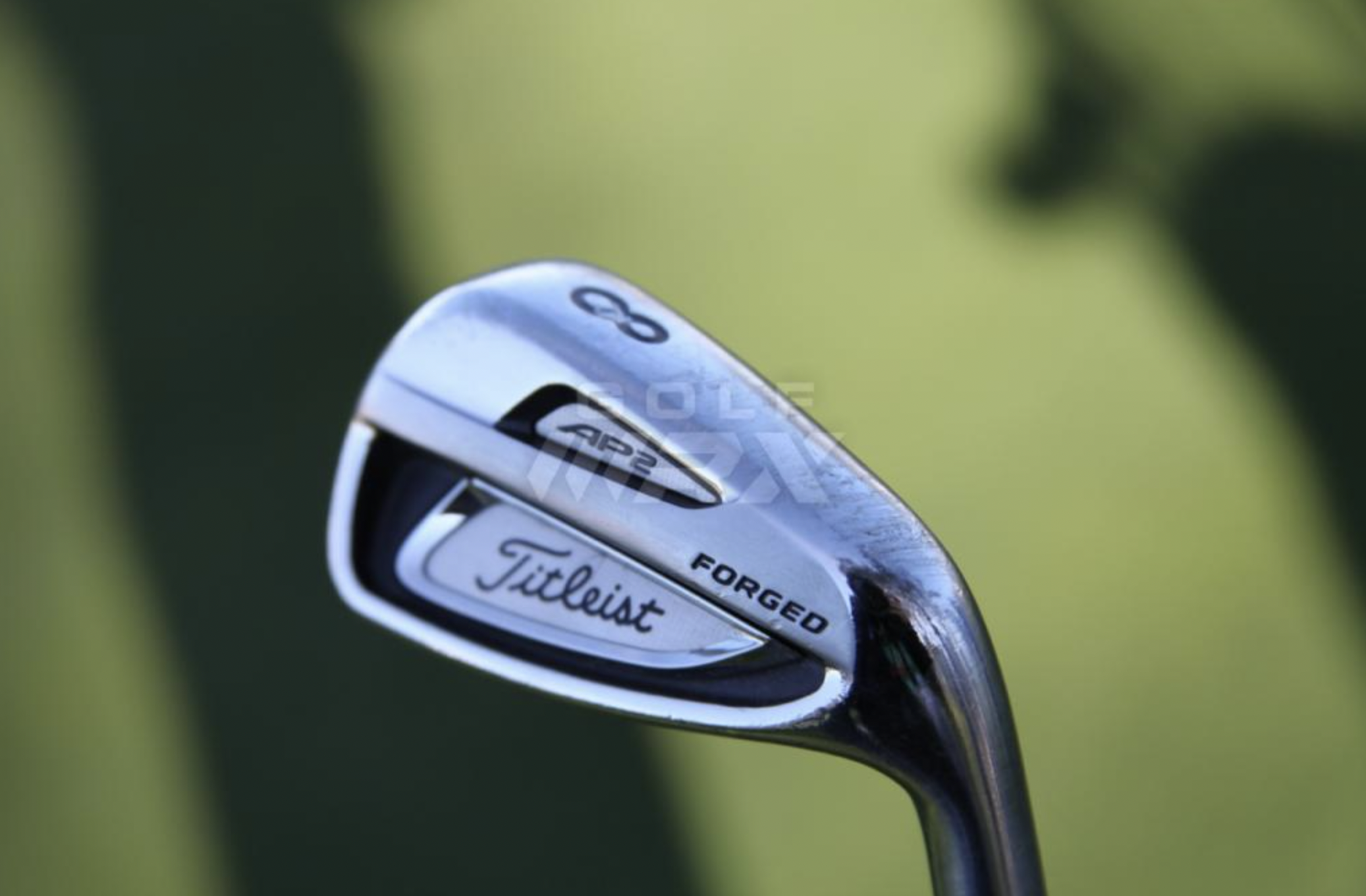
Wedges: Titleist Vokey Design SM5 (46-08F, 52-08F, 56-10S, 60-04L) Buy here.
Shafts: True Temper Project X 6.0
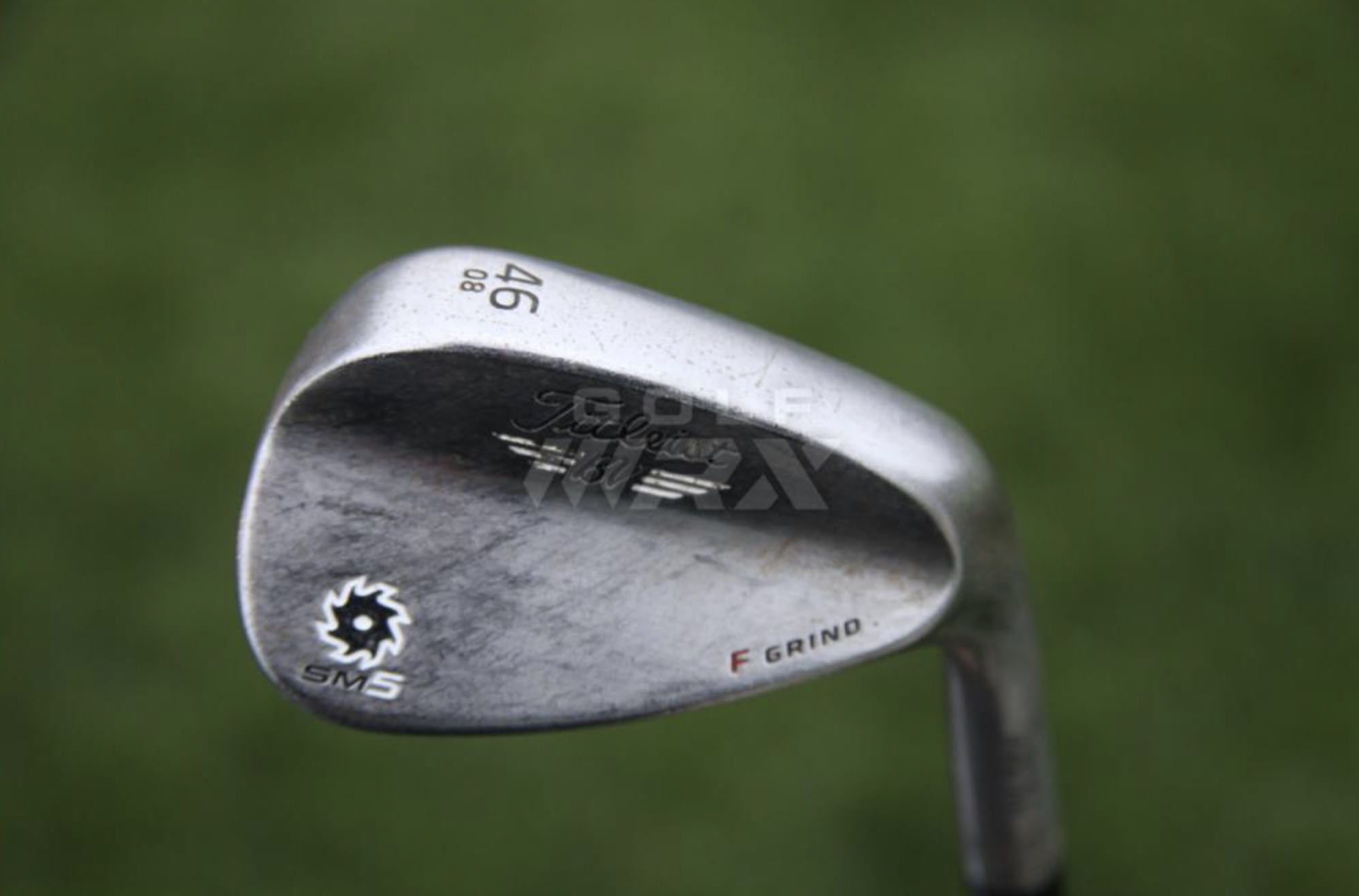
Putter: Scotty Cameron 009 Prototype Buy here.
Grip: SuperStroke Flatso Ultra (Black/White)
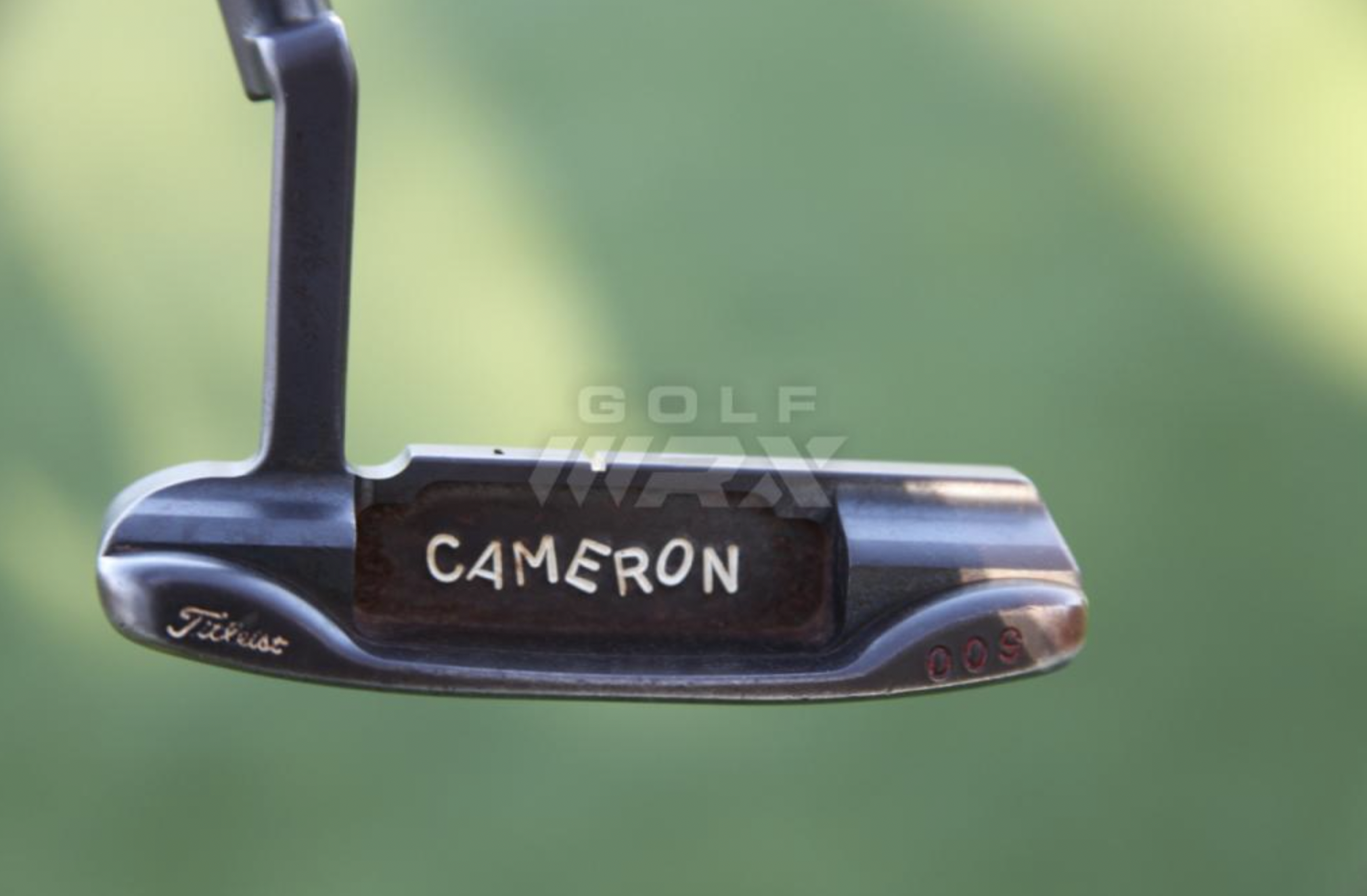
Ball: Titleist Pro V1x
Check out more photos of Jordan Spieth’s 2015 WITB here.
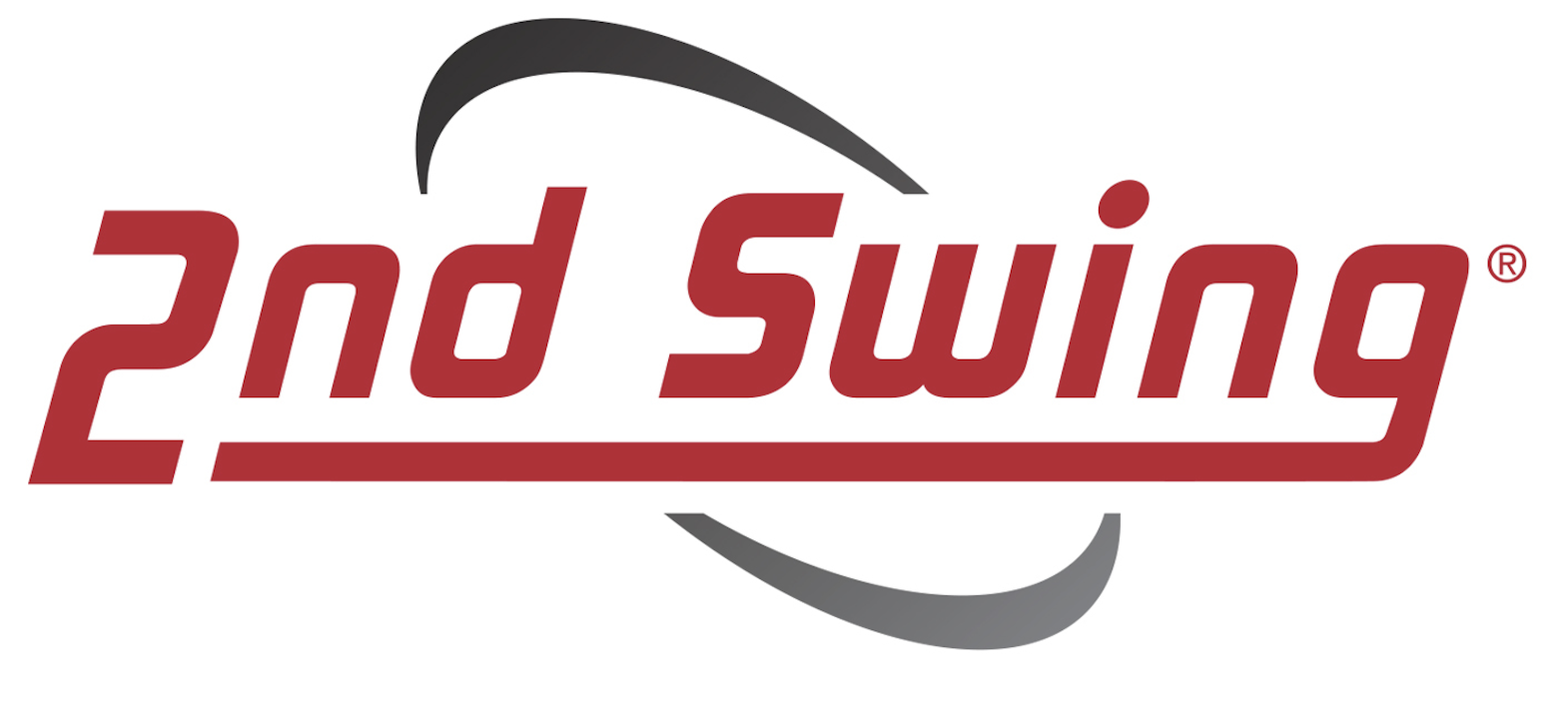
WITB Time Machine is presented by 2nd Swing Golf. 2nd Swing has more than 100,000 new and pre-swung golf clubs available in six store locations and online. Check them out here.
- LIKE1
- LEGIT1
- WOW0
- LOL0
- IDHT0
- FLOP1
- OB0
- SHANK0
Whats in the Bag
Michael Thorbjornsen WITB 2024 (July)

- Michael Thorbjornsen what’s in the bag accurate as of the John Deere Classic. Check out more photos from the event here.
Driver: TaylorMade Qi10 LS (9 degrees @7.5)
Shaft: Fujikura Ventus TR Blue 7 TX


4-wood: TaylorMade Qi10 Tour (16.5 degrees)
Shaft: Fujikura Ventus TR Blue 8 TX

Irons: TaylorMade P790 (2), TaylorMade P770 (3), TaylorMade P7MC (4-PW)
Shafts: True Temper Dynamic Gold X Seven (2), True Temper AMT Tour White X100 (3-PW)


Wedges: TaylorMade MG4 (50-09SB, 56-12SB, 60-09SBC)
Shafts: KBS Tour-V 120 X

Putter: TaylorMade Spider Tour S, Spider Tour X
Grip: SuperStroke Zenergy Tour 3.0 17


Grips: Golf Pride MCC
See more in-hand photos of Thorbjornsen’s WITB here.
- LIKE4
- LEGIT1
- WOW0
- LOL0
- IDHT0
- FLOP0
- OB0
- SHANK1
-

 News1 week ago
News1 week agoExperts on understanding ground force and how shoes can impact your golf game
-

 19th Hole3 weeks ago
19th Hole3 weeks ago‘Most overrated course in the world!’ – Major champ rips ‘awful’ Pinehurst No. 2
-

 19th Hole3 weeks ago
19th Hole3 weeks agoAimPoint under attack again as footage from U.S. Open enrages golf fans
-

 Equipment2 weeks ago
Equipment2 weeks agoMiura launches new forged wedge series
-

 19th Hole2 weeks ago
19th Hole2 weeks agoRory McIlroy releases statement following crushing U.S. Open loss
-

 19th Hole1 day ago
19th Hole1 day ago‘You’re right, we’re always wrong!’ – Sergio Garcia receives warning during Open qualifier
-

 Equipment3 weeks ago
Equipment3 weeks agoPatrick Cantlay switched driver, irons ahead of the U.S. Open
-

 19th Hole2 weeks ago
19th Hole2 weeks agoTour pro says Rory McIIroy needs to replace caddie Harry Diamond following U.S. Open collapse


























John Wayne Carlson
Jun 29, 2022 at 5:15 pm
“Up until the release of the first Edge iron, Hogan irons were strictly forged blades”. It’s a popular misconception that Hogan was forged only. The Hogan Company did cast clubs before the Edge starting with the Producers in 1975, followed by Magnum and single year of Radials before the Edges came out. Hogan himself loathed the cast clubs with a “hole” in them, but they were made and sold nonetheless. The Producer was the most expensive club in the Hogan line in the mid 1970s, even more expensive that the famous Apex Irons.
Dbeyr Orsee
Sep 7, 2020 at 1:13 pm
What an obvious marketing scam. The current Ben Hogan company has NOTHING to do with Ben Hogan’s company. They bought his name from Callaway, nothing else. The new company had some serious up and coming club designers back in 2015, when they went bankrupt. They are back as nothing but a fake marketing company – finding money spent on marketing has a better pay back. JJ Henry is the only “pro” using their clubs and he stopped winning tournaments right after switching to BH. He is no longer listed in the top 1,000 golfers, making just $23,160 – not enough to pay expenses. Not a single review of the best irons in 2020 included anything from the new and fake Ben Hogan.
The Ben Hogan company has nothing to do with the company and clubs of last century. Heck, it has nothing to do with the 2015 Ben Hogan company and clubs. They’re just high priced knock offs. At first, they sold clubs designed by Terry Koehler using his highly rated SCOR golf clubs (he’s now Edison Wedges). It’s like how some company just bought the Pier 1 name in the bankruptcy auction. Not the same people, not any of the systems, and of course not the same products. Just the name.
“The old myth about forged and cast iron heads is that forged heads are easy to bend, cast heads are not. Most forged iron heads are VERY easy to bend, some up to 4 degrees. Again – material dependent. There are quite a number of OEM iron heads that are difficult if not impossible to bend. Most if not all of these are cast heads.” Cast clubs tend to be more distance accurate. However, it’s only but geometry and material differences. The idea “forged” is special is a myth for people slow to learn. gameimprovementgolf.com/bending-forged-and-cast-irons-know-the-truth/
stephen hall
May 6, 2020 at 12:21 am
I had a set of HOGAN EDGE GS irons, had for about 25 yrs until they were stolen great irons Hogans are the best…
Joe
May 2, 2020 at 4:03 pm
Why can’t tour pros (PGA) play cool, quality irons like they are still producing today? IMO the PGA WITBs are quite redundant with every player signed to like 5 companies. Those ICON irons look SICK.
Billyjack
Apr 30, 2020 at 4:16 pm
Loved my Apex Ii irons with that Apex shaft. That wedge! Sad day when some crook stole them.
Richard Douglas
Apr 30, 2020 at 12:28 am
The Hogan Edge changed everything. Until then it was forged blades or 17-4 steel cavity-backed irons. The Edge brought the two concepts together.
This iron was my first real set of irons. I loved them, but went to even more forgiving clubs in a couple of years. But they were beautiful!
Kevin
Apr 29, 2020 at 11:15 pm
So, where do the Apex PC irons (circa 1985) fit into this thread? I have a set inherited from my father, 1 through E. I played them for years before changing to the recent Fort Worth 15 irons. Not sure the newer clubs have improved my game (about a 6 handicap). Those old blades are sweet to look at when addressing the ball. Given that 1, 2 and 3 irons are so rare these days, I’m never giving them up.
BingHogan
Apr 29, 2020 at 8:58 pm
I currently have a NEW set of Hogan PC’s. I played 9 holes with them about 5 years ago with the Apex shaft number 4 when I went back to Ohio to one of my old boyhood courses. I walked in the Pro shop and asked if I could rent some clubs etc.. to bring back some wonderful memories. They said they only had a few rentals that weren’t that good. But, we have a nice set of Hogan’s right there behind you for sale 3-E. Original grips and $35! Only the 8 iron and E were hit one time.
A great day!!
Jack Ryan
Apr 29, 2020 at 6:08 pm
I’ve had two sets of the +1s, two through wedge (one is in still in the garage). I had a set of the Edge–they were nice but heavy and the top line was too thick. I have a set of 92 Apex–also in the garage currently. I am currently playing the Ft Worth 15 and loving them.
TacklingDummy
Apr 29, 2020 at 4:27 pm
I had the Hogan FTX player forged irons. Progressive offset cavity back, but not much offset. Excellent set. Bagged them for several years until moving to Titleist AP2 then to the CBs.
Mark
Apr 29, 2020 at 4:24 pm
I have owned 3 sets of Hogans – Apex II, Apex Grind and Apex 1999. All were very good but the 1999 model was a standout in my opinion and it’s the set I wished I would have kept. I have played Mizuno for years now but I sure do miss that set.
Dean Mitchell
Apr 30, 2020 at 6:32 am
The 99s are the best clubs I’ve ever played golf with, and I also wish I’d kept mine. The most playable and beautiful muscle backs ever made.
cody
Apr 29, 2020 at 12:49 pm
You forgot to add the 1992 (I think) channel backs… some what copied by both Callaway in the prototypes and Mizuno with the MP5…
Rob
Apr 29, 2020 at 5:42 pm
1994 to 1996
chip75
Apr 29, 2020 at 11:58 am
Callaway make some nice sticks, but I’m not sure how they’ve done the Apex name “justice”? They bought Spalding (which I think was for the Strata ball) and acquired the Hogan assets, they kept the Apex name and repurposed it for nostalgic brand recognition.
Stacey Uchtman
Apr 29, 2020 at 4:32 pm
Agree, they should have let that name go with the brand.
Suncoast 9
Apr 29, 2020 at 11:53 am
Thanks for the walk down memory lane Ryan. My first top of the line set was Hogan Apex in 1973. After switching to Ram Tour Grind in ’87 I answered the cavity-back siren song with Hogan Edge in ’94. It was back to musclebacks with a 1999 set of Hogans, which finally gave way to my current Mizuno MP69s. I still have the ’99 Hogans tucked away in my basement, along with a PC 1-iron that I actually could hit half decently once upon a time.
Mark
Apr 29, 2020 at 11:13 am
Love Hogan clubs. My first set of golf clubs(bought used) was the 1959 version of the Starburst. Since then have sets of Percussion PC5, Bounce Sole, Round Sole, Producer, Radials (’83 version), Radials (’87 version), and Apex Redline. Most have been from ebay, with some bag chatter and some scuffing, but if you check them out before buying and with some cleaning, paint fill, re-grooving, and loft and lie adjustment they look and play well. While some of the 2, 3, and maybe 4 irons from these are displayed on the wall, I play the others. Still working on filling in the gaps by finding others, like Power Thrust, IPT, PT III, etc. Currently have 5 and 6 Radials and 7-Equalizer Round Soles in my bag. With the higher lofts when compared to current GI clubs, I am closer to having something like a 6.5 iron to Gap with these. The Radials are the most forgiving “blade like” club ever. (Shot my lowest 9 hole score ever last year with 5 – E Radials in the bag. OK, from the shorter tees since I am getting old and can’t hit it far enough anymore, but so what.) The Round Soles have “fairly” wide soles and set up nicely based on the sole curvature. In many ways, Mr. Hogan was ahead of his time. I would love to find a book or some kind of literature that would document the history of all clubs from the Precision to the mid to late 90s while Mr. Hogan was still active with the company. Anybody aware of that – I would love to know.
Mike
Apr 29, 2020 at 10:54 am
The ’99 Apex were my first blade irons… every set I’ve acquired since then are held to that immeasurable standard.
On a side note, I truly enjoyed the series of articles Tom Stites penned about his experience coming up at Hogan, but they seemed to end abruptly. Did this series end prematurely?
CaryK
Apr 29, 2020 at 10:28 am
I had a set of the original 1972 Apex irons. Great feeling clubs for their era. To me, though, the 1984 Hogan Apex PC (Percussion Center) might be one of his purest designs. The 1988 Apex Redline irons were also very beautiful as well. Hogan’s 1983 Radials were an interesting design too that might have been ahead of its time.
But my all time favorite is the 1952 Personal/Precision irons. I have a friend that has the limited edition boxed set that Hogan made in the 80’s. Just plain gorgeous!
Tom54
May 4, 2020 at 4:34 pm
You are indeed correct. I remember these too as I thought that they did not resemble any Hogan irons I had ever seen. I was never a fan of Ben Hogan irons but these were like a thousand dollars back in 83 a price unheard of at the time. Occasionally they will pop up on EBay but you will have to part with some serious cash for them. As I recall they were stunning looking irons.
Dave Burdette
Apr 29, 2020 at 10:27 am
I have a set of Slazenger Precisions forged in England. I’ve been trying to get information on these for the past 5 years. They are exactly like the 1954 irons with the exception of Slazenger on the soles and red leather grips. If you have any history of these, I’m all ears.
Thanks. Great article.
Suncoast 9
Apr 29, 2020 at 11:59 am
I had a set of Hogan clubs in 1973 that had Slazenger labels on the shafts. My understanding was Slazenger was licensed to manufacture (assemble?) Ben Hogan clubs outside of the US. The pro who sold me the clubs said the Slazenger label would be my proof to Canada customs that the clubs were bought in Canada.
Michael
Apr 29, 2020 at 9:48 am
Over the weekend, I was able to score a set of Edge CFT irons from a guy cleaning out his garage. They may not be fully forged (just the faces) like the sets listed in this article but they’re in great shape and very playable. My next find will hopefully be a set of the Apex irons you mentioned. Thanks for sharing this article- even this forty-something year old has a special affinity for classic Ben Hogan irons!!
Bob Jones
Apr 29, 2020 at 9:42 am
I bought a set of the 1999 Apexes and had them fitted for me. Wonderful clubs. When I was shopping, I tried a Ping i3+ and it felt just like the Hogans, but they looked funny and those 1999 Apexes appearance-wise are the tuxedos of the iron world.
I also bought a set of Red Lines (1988) on eBay and had them retro-fitted. I like them even better and for good reason. The Grinds (1990) are well thought of, too. At his death, Hogan had set of Apex II (white cameo) irons in his bag.
Cary
Nov 23, 2020 at 8:41 pm
I have hit both the the Ping I3+ and the Hogan ’99 blades and for me the Hogan’s were butter but also gave great feed back and I could tell exactly where on the face I hit them, but the I3+ were kind of numb feeling and I had no idea where on the face I hit them unless it was so far on the toe.